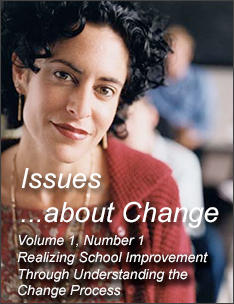The Innovation
In the 1970s a Rand Corporation study of federal programs supporting educational change revealed interesting findings regarding the implementation of these programs by school staff. One finding, labeled "mutual adaptation," pointed to the researchers' insights about the substantively different characteristics that the programs took on as they were implemented by teachers (Greenwood, Mann, & McLaughlin, 1975). In the same period, this phenomenon was reported also by Hall and Loucks (cited in Hall & Hord, 1987), who concluded that any one innovation usually appeared to have multiple configurations or operational patterns resulting from variations in teacher selection and use of the components of the innovations.
Such differences in the innovation's implementation in classrooms, or Innovation Configurations (Hall & Hord, 1987), were attributed to several factors, including: how the new program was introduced to teachers (and other intended users) in terms of clarity of description of the program, how complex the program was to incorporate into classroom practice, whether expectations for use of the program were established, and whether assistance was provided to potential users in their implementation efforts. Through discussions with many teachers and other educational staff involved in change, researchers have learned that practitioners typically lack clarity about what the innovation is at its introduction and subsequently what it should look like during implementation. Such a lack of definition leaves intended users with little understanding of the demands or requirements of the innovation and with impoverished mental images of what it should look like if it has been implemented in a high quality way. This problem has been found not only with innovations such as curriculum programs, instructional processes, strategies, and other new practices, but also with large-scale changes (such as restructuring) that seek to alter the fundamental ways schools operate (Van den Berg, 1981).
The effects of such lack of definition, or vision, have been demonstrated very clearly with, for instance, hands-on inquiry science programs. Inquiry science is predicated on students themselves interacting with materials, learning the skills of scientists through their own science investigation experiences, and constructing their own knowledge. There have been excellent examples of implementation of this model by teachers; however, what is called "inquiry science" can be found in classrooms where the teacher is the sole person manipulating the materials and the experiences, while students look on passively - not the intended operational form of the program at all. It is easy to understand in this case that what students learn from the actual implementation is far different from what was hoped to be gained from the intended implementation. Under such circumstances, hoped-for outcomes cannot be realized (James & Hord, 1988).
Both a tool and techniques for its use have been developed that enable the identification, articulation, and description of the components of an innovation. The framework of Innovation Configurations is this tool (Hall & Hord, 1987); it also includes a process whereby certain variations in implementing the components in classrooms are deemed "ideal," "acceptable," or "unacceptable," thus identifying areas of latitude in implementation for teachers and others. The message here is not that all teachers should necessarily be expected to implement all programs in an identical fashion; fidelity is not the theme. The theme is that intended users should be privileged to understand what the new program is all about, what it is expected to produce, and the various ways in which its implementation may produce the desired results. Until such issues as these are addressed, there can be little expectation that the desired change, and school improvement, will be reached through implementors' efforts.
So What?
It seems reasonable to suggest that "business as usual" will produce results as usual. Thus, if different results are desired, then "business" in the school and classroom will, of necessity, have to be different. Changes in the school staff's knowledge, understanding, skills, and behaviors will be required. This article argues that an innovation's demands for new skills and behaviors, and the individual's needs while implementing the new practices, will require interventions that give attention and support as the change process unfolds. Certainly, the organizational context in which implementation takes place is another critical factor for consideration, and it is the subject of another article in this series on leadership for change.
Although the issues of implementation raised here apply generically to any change effort, the Leadership for Change Project in the Southwest Educational Development Laboratory that is developing this series of articles, is focusing attention on the needs of at-risk students and the role that leadership at all educational levels can exercise in these students' behalf. To reach at-risk students with potentially powerful programs and strategies that increase student success, those programs must be implemented well in daily school and classroom practice. Supporting implementation is a function of leadership.
To conclude, when educational leaders understand and acknowledge that the change process itself is a factor to be accommodated in their school improvement efforts, when they consider the requirements of the changes or innovations that are introduced and the needs of all individuals who will be implementing the innovations, and when they develop plans that take these factors into account, then they will be providing leadership that guides, manages, and supports change. Only then will the likelihood of school improvement be realized.
Next Page: References and Credits

